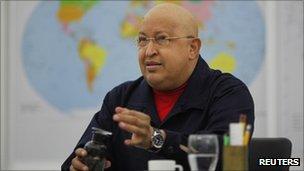Chavez cancer puts spotlight on Venezuela's healthcare
- Published

Crumbling public hospitals have to turn some patients away
The specialist kidney unit at El Algodonal hospital in a suburb of the Venezuelan capital, Caracas, is completely empty. So empty, you could hear a pin drop.
Despite boasting four dialysis machines, doctors here have been turning patients away since the hospital's water treatment plant broke down several months ago.
It is not the only problem facing the medical staff.
"We've got one CT scanner which hasn't worked for about two months now. The X-ray machine also doesn't work," says Dr Maria Yanez.
"We're missing a mammogram machine and only two operating theatres are functioning because the other two aren't fit for surgery."

Mr Chavez had treatment both in Cuba and Venezuela
Over the last few months, as President Hugo Chavez shuttled back and forth to Cuba for cancer treatment, the spotlight has been on health services in Venezuela.
Crumbling public hospitals are struggling to treat patients who often face long waits.
Doctors and nurses have held strikes to draw attention to their working conditions and the lack of basic supplies.
Following complaints by medical staff, Vice-President Elias Jaua recently visited El Algodonal and pledged to reconstruct and modernise the hospital.
"The irresponsibility of private contractors and the lack of control and tracking of their work means there are some jobs which are just paralysed," he said after inspecting stalled infrastructure programmes at the site.
Presidential scheme
But not everyone is convinced that these are the real reasons for the state of the country's hospitals.
Government opponents point to a new scheme set up by the president in 2003 as the source of many of the health service's problems.

El Algodonal's paediatric wing closed for renovations four years ago and has never been completed
The Barrio Adentro (Inside the Neighbourhood) scheme was designed to bring healthcare to the poorest areas of Venezuela's towns and cities by building new outpatient clinics in the country's slums.
Staffed almost exclusively by Cuban doctors, the clinics were established as a parallel health system to Venezuela's public hospitals, running alongside the existing services.
The clinics have been well equipped and patients that use them are pleased with the healthcare they have received.
"For humble people, who don't have money to travel to other hospitals, whether they're private or not, this is a great thing," one woman whose husband was being treated at a Barrio Adentro clinic not far from the presidential palace in Caracas told the BBC.
"There are good hospitals too, but they're full or the doctors are on strike and this is closer to my house."
'Irrational'
While the clinics are obviously helping some, running them in tandem with the public hospital system does not work, critics say.
Jorge Diaz, a health researcher at Venezuela's Central University, says maternal and child health indicators have both worsened since the introduction of Barrio Adentro.
He accuses the government of setting up the scheme as a political ploy to garner electoral support.
"You see a walk-in centre of the conventional health network and right next to it a module of Barrio Adentro," says Mr Diaz.
"It's absolutely irrational. There was no planning, there was no nothing, just building."
While the Barrio Adentro clinics have widened healthcare access, there are serious difficulties for patients who need hospital treatment.
Jose Moya, paralysed from the waist down, had to visit several hospitals before he found one with the resources to treat the large ulcer that had developed on his back.
"It can take a long time to be seen because the hospitals are completely full and often there are no supplies," he said from his bed on the surgical ward at El Algodonal.
"The doctors make themselves available when they can, but sometimes there's just no equipment."
President Chavez still enjoys positive approval ratings and is widely expected to triumph in next year's presidential election.
But amid wider grumbling over the economy, the funds funnelled into the Barrio Adentro scheme at the cost of the rest of the health service may end up costing Mr Chavez some votes.
- Published23 September 2011
- Published17 August 2011
- Published18 February 2013
- Published18 July 2011